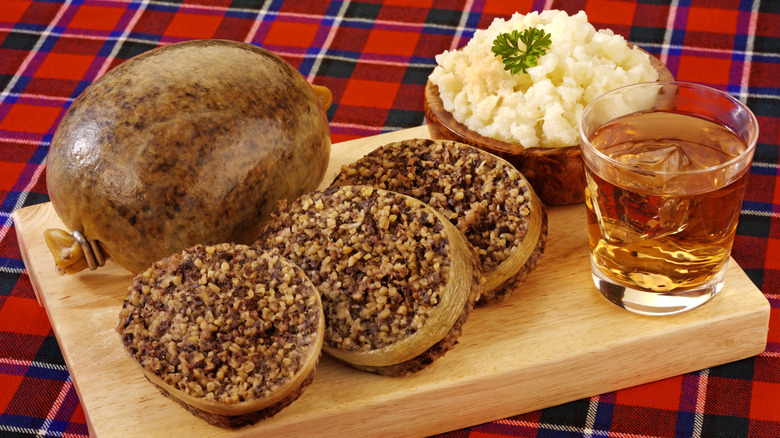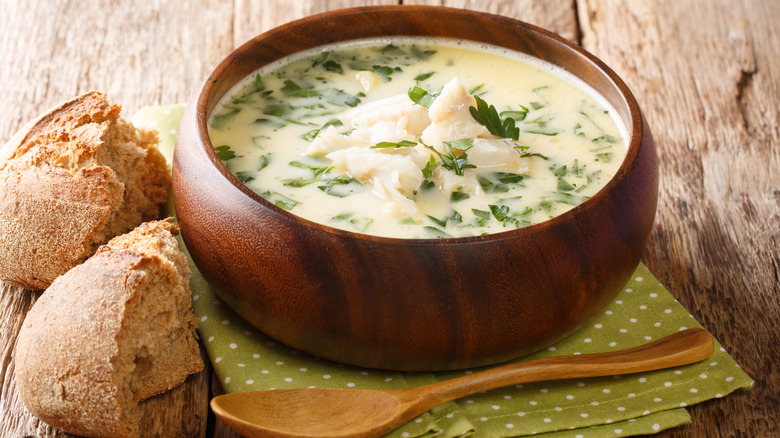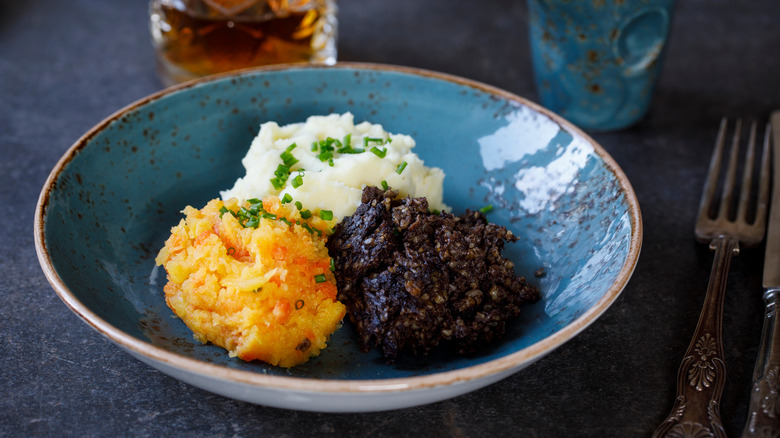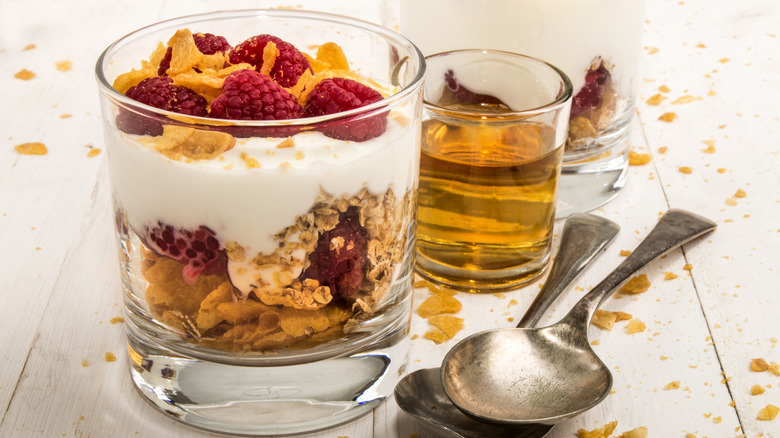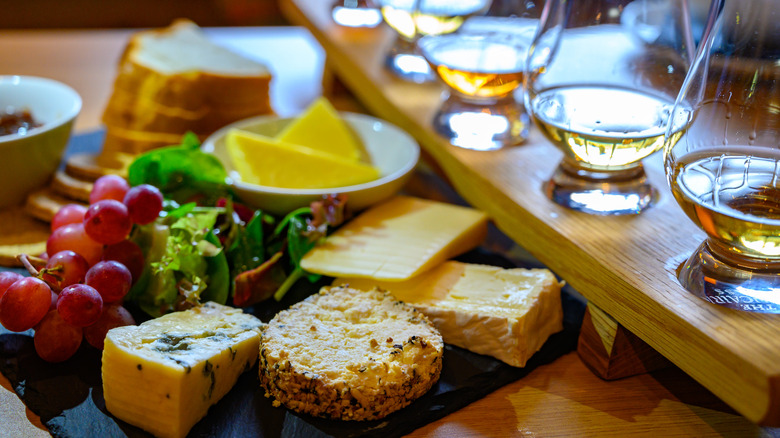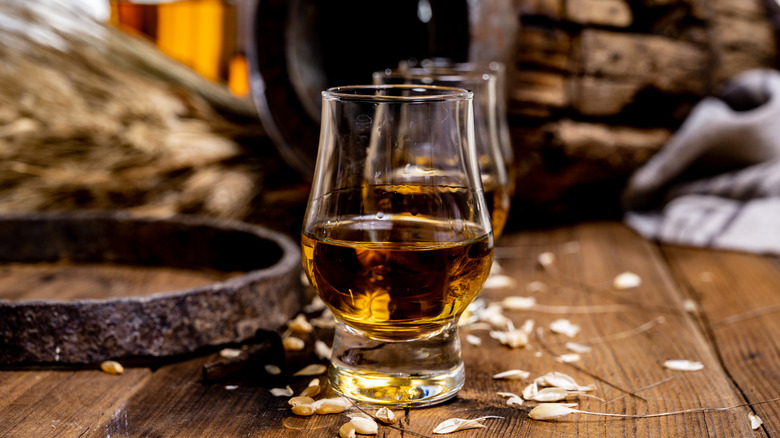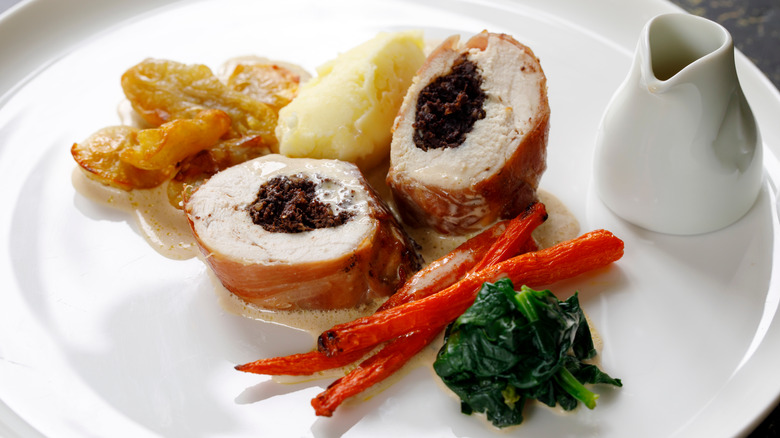The Foods Traditionally Served On Burns Night
Dust off your tartans and get ready to down a dram or two on January 25 with a satisfying dinner held in memory of Robert Burns, one of Scotland's most famous poets (via Christina's Cucina). The occasion, dubbed Burns Night, is traditionally celebrated by eating haggis, drinking whisky, reading poems, and sharing a festive spread with friends and loved ones — good enough reasons as any to circle a date on the calendar.
While commonly associated with the lyrics for the song "Auld Lang Syne," Burns himself insisted he got the words from "an old man's singing" and simply wrote them down for the first time in 1788, per Encyclopedia Britannica. We're not here to comment on Burns' accomplishments, but we do appreciate a proper feast, and Burns suppers seem to deliver.
First held in 1801 to commemorate the bard's birth, the University of Stirling notes, Burns Night involves an annual meal of haggis that has since been cemented as tradition, as well as a ceremony, toasts, and, of course, other dishes. Regardless of whether or not you live in Scotland or have Scottish friends, you too can whip up a meal worth celebrating — and we're here to help.
Kick off festivities with Cullen skink
To begin the meal, serve comforting, warm bowls of Cullen skink, a traditional Scottish soup hailing from Cullen, BBC Good Food suggests. Various recipes exist and Scottish chefs have tailored ingredients, substituting water with milk or mashing potatoes to create a thicker texture, per Cullen Skink, a website dedicated to the eponymous dish.
The soup was originally more broth-like and made with scrapings from cattle legs — what the Scots would call "skink" — but as fish became easier to find and use, that ingredient became the main protein for the most widely known rendition. Today, the celebratory starter typically includes haddock, potatoes, milk, onion, and parsley and can be topped with chopped chives and served with toasted bread.
Though this smoked fish chowder is a common Burns Night appetizer, Cock-a-Leekie — a soup made with chicken, leeks, and rice — is another fitting way to start the festive meal (via Christina's Cucina). Either of these soups can warm bellies as guests settle in and begin to read poems and song lyrics. Forever Edinburgh asserts that no two Burns suppers are the same, but before the main dish is brought to the table, bagpipes and applause can fill the air while the host recites "Address to a Haggis" — a work by Burns.
The main dish of Burns Night
The star of most Burns Night dinners is a plate of haggis, neeps, and tatties — generous servings of the Scottish delicacy with spoonfuls of mashed turnips (or rutabagas) and potatoes, per Christina's Cucina. Since Burns wrote a poem for haggis, it is only fitting that the dish is presented on silver platters, serenaded by bagpipes, and served ceremoniously during Burns suppers (via The Scotsman).
If you're outside of Scotland, haggis can be tricky to track down, BBC Good Food admits, but Scottish butchers and online markets may be able to help. Served baked or boiled, made with veggies or different kinds of meat, or topped with cream sauce or gravy, the varieties of haggis are aplenty, so you'll be able to accommodate the preferences of the diners in attendance.
The side dishes neeps and tatties also come in variations. While the two foods are typically served separately, Prima suggests that some hosts mash the two together or serve them as crispy pan-fried cakes to contrast with the softer texture of the haggis. To make room for the next course, Visit Scotland has a themed playlist to get you moving.
Sweet finishes
Scotland offers plenty of sweet treats to cap off hearty meals, but Cranachan, Clootie Dumpling, and Tipsy Laird are standard crowd favorites to conclude a Burns supper, Scottish Scran insists. Cranachan is a layered dessert that features raspberries, oats, cream, heather honey, and whisky, per a recipe from BBC Good Food. Clootie Dumpling is another traditional recipe often eaten during the winter months, but this pudding is a heavier "stick-to-your-ribs" kind of treat that may be tougher to enjoy after a Scottish feast, as The Wee Larder explains on YouTube.
For lighter dessert offerings, the spongy Tipsy Laird (also known as Typsy Laird) is a trifle commonly found at Burns suppers or New Year's celebrations (via Scottish Recipes). It earned its name because the combination of sherry with brandy or Drambuie whisky liqueur in the recipe is said to make diners a bit tipsy. For a non-alcoholic sweet, the traditional Scottish tablet can accompany coffee and tea.
If you'd rather skip sweets and serve something savory to end the supper, a Scottish cheeseboard can act as a fine punctuation to a thoughtfully prepared dinner.
The fine world of Scottish cheese
A well-assembled board of Scottish cheeses can serve as the perfect Burns Night treat, per The Wee Larder. With the addition of homemade jellies, chutneys, and oatcakes, you'll have another impressive presentation to offer at your celebratory dinner. Some of the world's best cheese comes out of Scotland, Fine Scottish Hampers claims, and serving cheese after dinner allows hosts to get a bit more creative and customize.
Aim to serve around two ounces of cheese per guest, and look for a Highland Brie, buttery Scottish cheddar, and a soft Crowdie, The Wee Larder suggests. Liverpool Cheese Company brings together salty Isle of Mull cheddar, creamy Gruth Dhu, sharp Hebridean Blue, Highland Chief whisky cheese, earthy Clava Brie, and oatcakes to make a board fit for any Scot. Whatever your spread looks like, consider including fruits, such as sliced apples and pears, dried figs, and blackberries, to add sweetness.
Pour a few drams
Of course, no Scottish feast is complete without a dram — or several. Get ready for toasts. Many toasts. As long as the whisky you pour is Scottish, you can't go wrong, per The Cocktail Society. Peaty labels, smoky whiskies, and fruit-forward drams can all help liven up your evening. The Evening Standard adds that the taste of a whisky differs depending on which region it is from, but any variety that has been aged in sherry casks is a solid choice.
If whisky served straight up isn't your fancy, BBC Good Food recommends mixing the spirit into cocktails, such as an Old Fashioned or the classic whisky highball. The Cocktail Society suggests that the hot toddy, whisky sour, mulled cider, and hot buttered rum are also appropriate to serve during the night. For a more refreshing tipple, Country & Town House provides a recipe for Laphroaig Smoked Mule — crafted by stirring Laphroaig Quarter Cask and lime juice in a glass, topping it off with ginger beer, and garnishing with a wedge of lemon or lime. The evening may pass by more quickly than you'd expect.
Burns Night dinner alternatives
If this feast sounds like a lot to put together, you have plenty of other choices, Scottish Scran assures. For a smaller dinner celebration, you can prepare Chicken Balmoral — a chicken stuffed with haggis, wrapped in bacon, and topped with a sauce made with whisky. This tasty dish is named after the picturesque Balmoral Castle, a beloved vacation destination for British royalty (via the Scottish Cultural Organization of the Triangle). Though the recipe takes a bit of preparation and time to complete, it is fit for any audience. Additionally, serving a hearty Scotch broth instead of the usual haggis can make for a fine feast too, per BBC Good Food.
To officially end the evening, the host thanks the attendees, VisitScotland instructs. Then, everyone stands up to sing "Auld Lang Syne," holding hands at the line "And there's a hand, my trusty fere!" House & Garden helpfully recommends having the lyrics printed out since, by the end of the night, there's a good chance your guests are quite well-fed and have had their fill of Scot-honoring libations.
